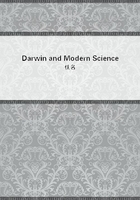
第71章
With this I conclude my brief survey of the rich contents of Darwin's book.
I may be permitted to conclude by quoting the magnificent final words of "The Descent of Man": "We must, however, acknowledge, as it seems to me, that man, with all his noble qualities, with sympathy which feels for the most debased, with benevolence which extends not only to other men but to the humblest living creature, with his god-like intellect which has penetrated into the movements and constitution of the solar system--with all these exalted powers--Man still bears in his bodily frame the indelible stamp of his lowly origin." (Ibid. page 947.)What has been the fate of Darwin's doctrines since his great achievement?
How have they been received and followed up by the scientific and lay world? And what do the successors of the mighty hero and genius think now in regard to the origin of the human race?
At the present time we are incomparably more favourably placed than Darwin was for answering this question of all questions. We have at our command an incomparably greater wealth of material than he had at his disposal.
And we are more fortunate than he in this respect, that we now know transition-forms which help to fill up the gap, still great, between the lowest human races and the highest apes. Let us consider for a little the more essential additions to our knowledge since the publication of "The Descent of Man".
Since that time our knowledge of animal embryos has increased enormously.
While Darwin was obliged to content himself with comparing a human embryo with that of a dog, there are now available the youngest embryos of monkeys of all possible groups (Orang, Gibbon, Semnopithecus, Macacus), thanks to Selenka's most successful tour in the East Indies in search of such material. We can now compare corresponding stages of the lower monkeys and of the Anthropoid apes with human embryos, and convince ourselves of their great resemblance to one another, thus strengthening enormously the armour prepared by Darwin in defence of his view on man's nearest relatives. It may be said that Selenka's material fils up the blanks in Darwin's array of proofs in the most satisfactory manner.
The deepening of our knowledge of comparative anatomy also gives us much surer foundations than those on which Darwin was obliged to build. Just of late there have been many workers in the domain of the anatomy of apes and lemurs, and their investigations extend to the most different organs. Our knowledge of fossil apes and lemurs has also become much wider and more exact since Darwin's time: the fossil lemurs have been especially worked up by Cope, Forsyth Major, Ameghino, and others. Darwin knew very little about fossil monkeys. He mentions two or three anthropoid apes as occurring in the Miocene of Europe ("Descent of Man", page 240.), but only names Dryopithecus, the largest form from the Miocene of France. It was erroneously supposed that this form was related to Hylobates. We now know not only a form that actually stands near to the gibbon (Pliopithecus), and remains of other anthropoids (Pliohylobates and the fossil chimpanzee, Palaeopithecus), but also several lower catarrhine monkeys, of which Mesopithecus, a form nearly related to the modern Sacred Monkeys (a species of Semnopithecus) and found in strata of the Miocene period in Greece, is the most important. Quite recently, too, Ameghino's investigations have made us acquainted with fossil monkeys from South America (Anthropops, Homunculus), which, according to their discoverer, are to be regarded as in the line of human descent.
What Darwin missed most of all--intermediate forms between apes and man--has been recently furnished. (E. Dubois, as is well known, discovered in 1893, near Trinil in Java, in the alluvial deposits of the river Bengawan, an important form represented by a skull-cap, some molars, and a femur.
His opinion--much disputed as it has been--that in this form, which he named Pithecanthropus, he has found a long-desired transition-form is shared by the present writer. And although the geological age of these fossils, which, according to Dubois, belong to the uppermost Tertiary series, the Pliocene, has recently been fixed at a later date (the older Diluvium), the MORPHOLOGICAL VALUE of these interesting remains, that is, the intermediate position of Pithecanthropus, still holds good. Volz says with justice ("Das geologische Alter der Pithecanthropus-Schichten bei Trinil, Ost-Java". "Neues Jahrb. f.Mineralogie". Festband, 1907.), that even if Pithecanthropus is not THE missing link, it is undoubtedly _A_missing link.
As on the one hand there has been found in Pithecanthropus a form which, though intermediate between apes and man, is nevertheless more closely allied to the apes, so on the other hand, much progress has been made since Darwin's day in the discovery and description of the older human remains.
Since the famous roof of a skull and the bones of the extremities belonging to it were found in 1856 in the Neandertal near Dusseldorf, the most varied judgments have been expressed in regard to the significance of the remains and of the skull in particular. In Darwin's "Descent of Man" there is only a passing allusion to them ("Descent of Man", page 82.) in connection with the discussion of the skull-capacity, although the investigations of Schaaffhausen, King, and Huxley were then known. I believe I have shown, in a series of papers, that the skull in question belongs to a form different from any of the races of man now living, and, with King and Cope, I regard it as at least a different species from living man, and have therefore designated it Homo primigenius. The form unquestionably belongs to the older Diluvium, and in the later Diluvium human forms already appear, which agree in all essential points with existing human races.